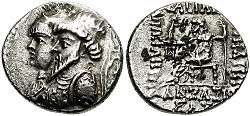Elymais
| Elymais | ||||||||
| Vassal of Parthia | ||||||||
| ||||||||
 Approximate extent of Elymais in 51 BC. | ||||||||
| Capital | Susa | |||||||
| Government | Monarchy | |||||||
| King | ||||||||
| • | ca. 147 BC | Kamnaskires I Soter | ||||||
| • | 224 AD | Orodes VI | ||||||
| Historical era | Classical antiquity | |||||||
| • | Established | 147 BC | ||||||
| • | Disestablished | 224 AD | ||||||
| ||||||||
| Warning: Value specified for "continent" does not comply | ||||||||
Elymais or Elamais (Ἐλυμαΐς, Hellenic form of the more ancient name, Elam) was a semi-independent state of the 2nd century BC to the early 3rd century AD, frequently a vassal under Parthian control, and located at the head of the Persian Gulf in the present-day region of Khuzestan, Iran (Susiana).[1] It is reported that these people were great archers and natives of Susa, which lay to the east of Elymais territory. Most of the Elymais were probably descendants of the ancient Elamites,[1] who once had control of that area in the past. The provinces of Elymais were Massabatice (later Masabadhan), Corbiane and Gabiane.
Nothing is known of their language, even though Elamite was still used by the Achaemenid Empire 250 years before the Elymais came into existence.[2] A number of Aramaic inscriptions are found in Elymais.[3] The kingdom of Elymais survived until its extinction by a Sassanid invasion in the early 3rd century AD.
It is reported in 2 Maccabees that the priests of the temple of Nanea, which is located in Susa, tricked Antiochus IV Epiphanes and murdered him by throwing rocks on him and dismembering him (2Macc 1:10–17).
Coinage

The coins of Elymais depicted a king; it is not known whether this was a Parthian king or a local ruler, as such information has not come to light. These coins were based on Greek standards of debased Drachms and Tetradrachms. The royal picture is generally based on Parthian coinage, usually with an anchor with a star in crescent figure. The reverse has a figure or bust of Artemis with text around it, an eagle, or often only elongated dots (this has led numismatists to believe that the engravers didn't know Greek or copied from coins whose writing was already unintelligible).[4]
Kings of Elymais
List of rulers[5]
- Kamnaskires I Megas Soter (c. 147- c.145 BC)
- Kamnaskires II Nikephoros (c 145- C. 139 BC)
- Okkonapses (c. 139/8 BC)
- Tigraios (c. 138/7- c. 133/2 bc)
- Darius (before c. 129 BC)
- Kamnaskires III Megas Nikephorus (c. 85 BC)
- Kamnaskires IV (c. 82/1- c. 76/5 BC) with Anzaze (his Queen)
- Kamnaskires V[6] (c. 73/2- c. 46 BC)
- Kamnaskires VI[7] (c. 46- c. 28 BC)
- Kamnaskires VII[8] (c. 28 BC- c. 1 AD)
- Kamnaskires VIII[9] (c. 1- c. 15 AD)
- Kamnaskires IX[10] (c. 15- c. 25 AD)
- Orodes I (c. 25- c. 50 AD)
- Orodes II (c. 50- c. 70 AD) son of Orodes I
- Phraates[11] (c. 70- c. 90 AD) son of Orodes (I or II)
- Orodes III[12] (c. 90- c. 100 AD) son of Orodes II
- Kamnaskires-Orodes[13] (c. 100- c. 120 AD) son of Orodes II
- Ariobarzanes (c. 125 AD)
- Osroes (c. 125-c. 130 AD)
- Unknown King I (c. 130- c. 140 AD)
- Orodes IV[14] & Ulpan (c. 140- c. 160 AD)
- Abarbasi[15] (c. 160- c. 170 AD)
- Orodes V[16] (c. 170- c. 180 AD) son of Beldusa
- Vologases[17] (c. 180- c. 190 AD)
- Unknown King II[18] (c. 190- c. 210 AD)
- Unknown King III[19] (c. 210- c. 220 AD)
- Orodes VI[20] (c. 220- 224 AD)
See also
References
- 1 2 Hansman, John F. "ELYMAIS". Encyclopædia Iranica. Retrieved 2012-12-24.
- ↑ G. Cameron Persepolis Treasury Tablets (1948), and R. Hallock, Persepolis Fortification Tablets (1969). See also Persepolis Fortification Archive.
- ↑ Gzella, H. (2008) Aramaic in the Parthian Period: The Arsacid Inscriptions. In Gzella, H. & Folmer, M.L. (Eds.) Aramaic in its Historical and Linguistic Setting. Wiesbaden. P. 107-130
- ↑ Coins of Elymais
- ↑ Wiesehöfer, 1996, p. 318. Pakzadian, 2007, pp. 56-57 & VII-X.
- ↑ According to Pakzadian, 2007: Kamnaskires V, VI, VII, VIII and IX.
- ↑ According to Pakzadian, 2007: Kamnaskires X and XI.
- ↑ According to Pakzadian, 2007: Kamnaskires XII and XIII.
- ↑ According to Pakzadian, 2007: Kamnaskires XIV and XV.
- ↑ According to Pakzadian, 2007: Late Kamnaskires Successors types 1, 2 and 3.
- ↑ According to Pakzadian, 2007: Phraates I, II and III.
- ↑ According to Pakzadian, 2007: Orodes III and IV.
- ↑ According to Pakzadian, 2007: Kamnaskires-Orodes I and II.
- ↑ According to Pakzadian, 2007: Orodes V, VI and VII.
- ↑ According to Pakzadian, 2007: 1st Unknown King (A)
- ↑ According to Pakzadian, 2007: Unknown Kings 2nd(B), 3rd(C) and 4th(D)
- ↑ According to Pakzadian, 2007: Vologases I and II.
- ↑ According to Pakzadian, 2007: Unknown Kings 5th(E), 6th(F) and 7th(G)
- ↑ According to Pakzadian, 2007: Unknown Kings 8th(H) and 9th(I)
- ↑ According to Pakzadian, 2007: 10th Unknown King (J)
Bibliography
- Pakzadian, Hasan. "The Coins of Elymais", Tehran, 2007. (in Persian)
- The Cambridge History of Iran (CHI), vol. 3(I), THE SELEUCID, PARTHIAN AND SASANIAN PERIODS, Cambridge University Press, 1983.
- The Cambridge History of Iran (CHI), vol. 3(II), THE SELEUCID, PARTHIAN AND SASANIAN PERIODS, Cambridge University Press, 1983.
- Wiesehöfer, Josef, "ANCIENT PERSIA from 550 BC to 650 AD", tr. by Azizeh Azodi, I.B.Tauris Publishers, London, 1996.
- www.parthia.com
External links
- Elymais coinage
- About Elymais and the type of coinage
- http://www.grifterrec.com/coins/elymais/elymais.html
- http://www.seleukids.org/Elymais.html
- Some history and coin definitions